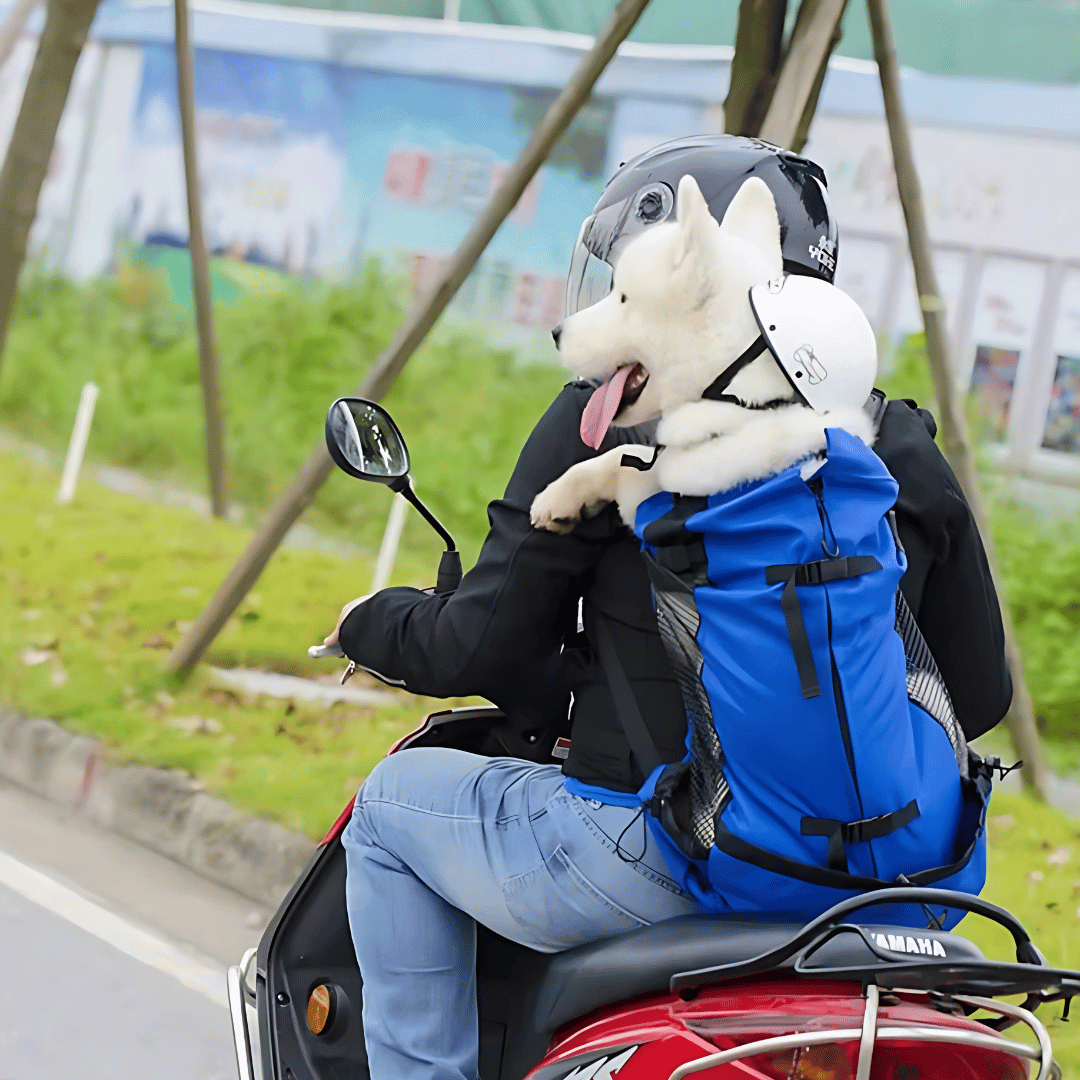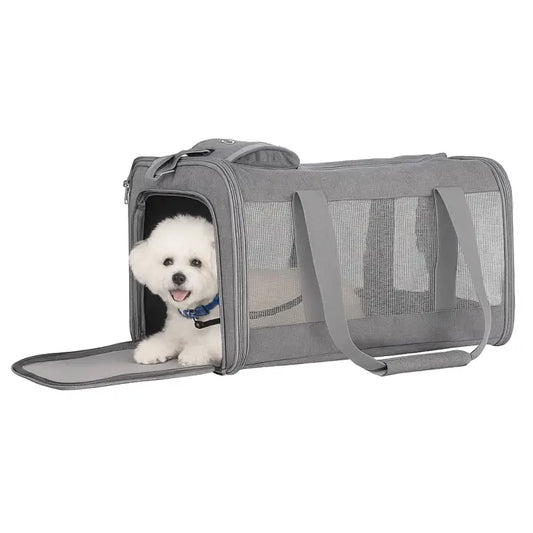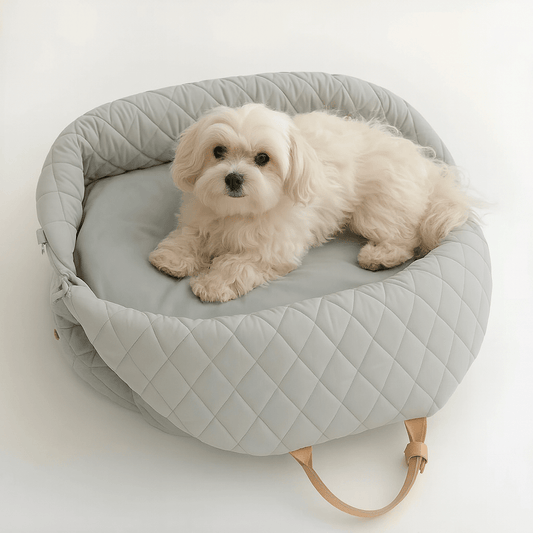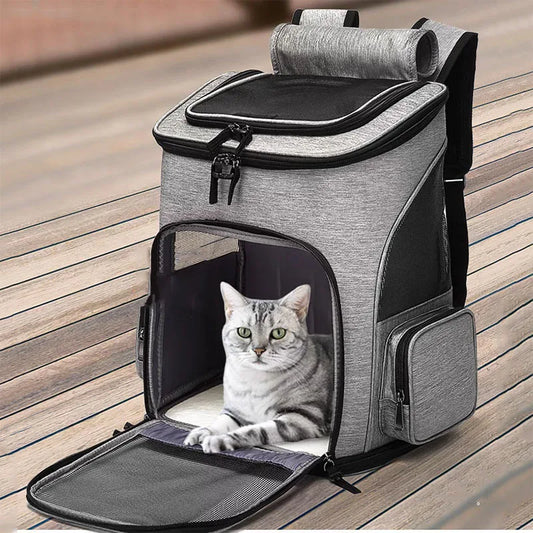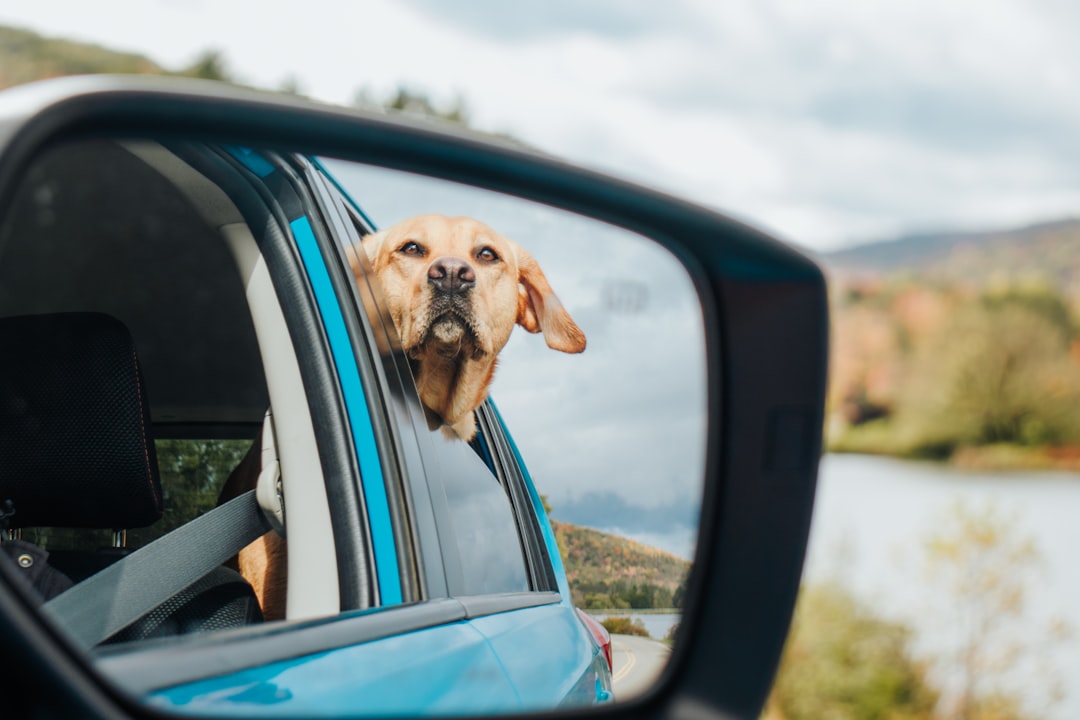
Cómo preparar a tu perro para un viaje largo por carretera: consejos de seguridad y elementos esenciales para el viaje
Compartir
Emprender un largo viaje por carretera con tu perro puede ser una aventura divertida, pero requiere una planificación cuidadosa para garantizar su seguridad y comodidad. La seguridad en los viajes por carretera con tu perro es una prioridad absoluta, y con la preparación adecuada, puedes crear una experiencia agradable tanto para ti como para tu amigo peludo.
Antes de salir de viaje, es fundamental considerar los aspectos esenciales, como la salud, la comodidad y la seguridad de su perro. Esto incluye empacar los suministros necesarios, planificar descansos regulares y preparar el vehículo para su mascota.
Conclusiones clave
- Planifique descansos regulares para hacer ejercicio e hidratarse.
- Empaque suministros esenciales, incluidos alimentos, agua y medicamentos.
- Prepare su vehículo para el viaje de su mascota
- Tenga en cuenta las necesidades de salud y comodidad de su perro.
- Investiga destinos y alojamientos que admitan mascotas
Planificación anticipada: controles veterinarios y documentación previos al viaje
Un viaje por carretera exitoso con tu perro comienza con una preparación exhaustiva, que incluye una revisión veterinaria previa. Garantizar la salud de tu perro y contar con la documentación necesaria es crucial para un viaje seguro y placentero. Esta preparación no solo protege la salud de tu perro, sino que también cumple con los requisitos legales para viajar con mascotas.
Certificados de salud y vacunas esenciales
Antes de viajar, es fundamental obtener un certificado sanitario para su perro, que suele emitirse en los 10 días previos al viaje. Este certificado garantiza que su perro está en buen estado de salud para viajar y que ha sido vacunado contra enfermedades como la rabia. Las vacunas específicas requeridas pueden variar según el destino, por lo que es fundamental consultar con su veterinario.
Microchip y etiquetas de identificación: cómo garantizar la identificación de su perro
Colocarle un microchip a su perro y asegurarse de que sus placas de identificación estén al día son pasos vitales para prepararse para el viaje. El microchip proporciona una identificación permanente que puede ser crucial si su perro se pierde. Además, asegúrese de que las placas de identificación de su perro incluyan su nombre, el suyo y su información de contacto.
Suministros de medicamentos y consideraciones especiales de salud
Si su perro necesita algún medicamento, asegúrese de llevar suficientes provisiones para todo el viaje, además de algunas adicionales por si hay retrasos inesperados. También es recomendable llevar una copia del historial médico de su perro y una lista de contactos veterinarios de emergencia a lo largo de la ruta.
| Tarea de preparación previa al viaje | Descripción | Nivel de importancia |
|---|---|---|
| Certificado de salud | Emitido por un veterinario dentro de los 10 días previos al viaje. | Alto |
| Vacunas | Garantizar el cumplimiento de los requisitos del destino | Alto |
| Microchip | Identificación permanente para su perro | Alto |
| Etiquetas de identificación | Información de contacto actualizada | Alto |
| Suministros de medicamentos | Empaca lo suficiente para el viaje más extras. | Alto |
Cómo preparar a tu perro para un largo viaje por carretera mediante entrenamiento y aclimatación
Para garantizar un viaje tranquilo y placentero tanto para usted como para su perro, es fundamental comenzar a entrenar y aclimatar a su mascota con suficiente antelación. Esta preparación no solo mejora la comodidad de su perro, sino que también reduce significativamente el riesgo de estrés y ansiedad relacionados con el viaje.
Paseos cortos de práctica: cómo aumentar la comodidad de su perro
Empieza por llevar a tu perro a dar paseos cortos de práctica por tu vecindario o parque local. Estos primeros paseos le ayudarán a acostumbrarse al movimiento, los sonidos y los olores del coche. Empieza con sesiones cortas y aumenta la duración gradualmente a medida que tu perro se sienta más cómodo. Esta exposición gradual es clave para prevenir el mareo por movimiento y reducir la ansiedad.
- Comience con recorridos cortos para que su perro se acostumbre al automóvil.
- Aumente gradualmente la duración de los viajes.
- Controle el nivel de comodidad de su perro y ajústelo según corresponda.
Comandos y comportamientos específicos del automóvil para enseñar
Enseñarle a tu perro órdenes específicas para el coche puede mejorar la seguridad durante el viaje. Órdenes como "tranquilo" o "relájate" pueden ayudar a calmarlo durante el viaje. La constancia es clave ; utiliza técnicas de refuerzo positivo como premios y elogios para fomentar el buen comportamiento. Además, enseñarle a tu perro a viajar con calma en el coche puede evitar distracciones al volante.
Entrenar a tu perro para que responda a órdenes específicas en el coche puede marcar una diferencia significativa en su comodidad y en tu seguridad durante el viaje.
Entrenamiento con jaulas para viajes seguros
El entrenamiento con jaula es una forma eficaz de garantizar la seguridad de tu perro durante el viaje. Una jaula proporciona un espacio seguro y cómodo para que tu perro viaje, lo que reduce el riesgo de lesiones por frenadas repentinas o accidentes. Introduce la jaula gradualmente, convirtiéndola en un espacio cómodo con ropa de cama y juguetes que le resulten familiares.
Al incorporar estas estrategias de entrenamiento y aclimatación, puede mejorar significativamente la experiencia de viaje por carretera de su perro, garantizando un viaje más seguro y placentero para ambos.
Equipo de seguridad esencial para perros que viajan por carretera
Viajar con perros requiere una planificación cuidadosa, y uno de los aspectos más importantes es equipar el vehículo con el equipo de seguridad adecuado. Garantizar la seguridad de tu perro durante los viajes por carretera no solo lo protege, sino que también ayuda a evitar distracciones al volante, haciendo el viaje más seguro para todos.
Cinturones de seguridad, arneses y transportines para perros: ventajas y desventajas
Los cinturones de seguridad, arneses y transportines para perros están diseñados para mantener a tu perro seguro mientras viajas. Los cinturones de seguridad se fijan al arnés y luego al sistema de cinturones de seguridad del coche, evitando que se mueva dentro del vehículo. Los arneses proporcionan mayor sujeción y comodidad, distribuyendo la fuerza del cinturón de seguridad por el pecho y los hombros del perro. Los transportines , por otro lado, ofrecen un espacio más cómodo para tu perro, lo cual puede ser especialmente útil para razas pequeñas.
Cada una de estas opciones tiene sus ventajas y desventajas. Por ejemplo, si bien los cinturones de seguridad para perros son eficaces, podrían no ser adecuados para todos los tamaños o temperamentos. Los arneses ofrecen comodidad, pero requieren un ajuste adecuado para ser efectivos. Los transportines ofrecen un espacio seguro, pero podrían no ser prácticos para perros grandes.
Barreras y soluciones para áreas de carga para perros grandes
Para perros más grandes, las barreras y las soluciones para el área de carga son esenciales. Las barreras separan al perro de los asientos delanteros, evitando distracciones al conducir y manteniéndolo seguro. Las soluciones para el área de carga, como los divisores de carga o las jaulas para perros , están diseñadas para mantener a su perro seguro en la parte trasera del vehículo.
Estas soluciones no solo protegen a su perro, sino también al conductor y a los pasajeros, minimizando posibles distracciones. Al elegir una barrera o una solución para el área de carga, tenga en cuenta el tamaño de su perro y del vehículo para asegurar un ajuste perfecto.
Persianas y dispositivos de control de temperatura
Las persianas protegen a tu perro de la luz solar directa, reduciendo el riesgo de sobrecalentamiento y malestar. Los dispositivos de control de temperatura te permiten controlar la temperatura del coche, garantizando que se mantenga dentro de un rango seguro para tu perro.
Estos accesorios son cruciales para mantener un entorno cómodo y seguro para tu perro durante el viaje. Controlando la temperatura y la luz solar, puedes prevenir golpes de calor y reducir su estrés.
Creando un espacio de viaje cómodo para tu perro
Para que tu perro esté feliz y relajado durante el viaje, es fundamental crear un espacio de viaje cómodo. Un espacio de viaje bien preparado puede reducir significativamente el estrés de tu perro y hacer que el viaje sea placentero para ambos.
Ropa de cama y juguetes familiares: Trayendo comodidad desde casa
Llevar elementos del entorno doméstico de tu perro puede brindarle una sensación de familiaridad y comodidad durante el viaje. Incluir su ropa de cama o juguetes favoritos puede ser muy relajante. Asegúrate de que estos artículos estén bien guardados para evitar que se conviertan en proyectiles durante el viaje.
Consideraciones sobre el control de temperatura y la ventilación
Mantener una temperatura agradable y una buena ventilación son fundamentales para la comodidad de su perro. Nunca deje a su perro en un coche caliente , ya que las temperaturas pueden volverse peligrosas rápidamente. Use persianas y asegúrese de que el aire acondicionado o la calefacción de su vehículo funcionen correctamente.
Gestión del espacio: Dale a tu perro espacio para ajustar su posición
Es fundamental darle a tu perro suficiente espacio para que se adapte a su posición durante el viaje. Un espacio reducido puede causarle incomodidad y ansiedad . Considera usar un arnés o un transportín que permita cierto movimiento.
| Medida de comodidad | Beneficio |
|---|---|
| Ropa de cama familiar | Proporciona comodidad y reduce la ansiedad. |
| Control de temperatura | Previene el sobrecalentamiento y garantiza el confort. |
| Gestión del espacio | Permite el movimiento y reduce los calambres. |
Estrategias de nutrición e hidratación para el viaje
Al emprender un largo viaje por carretera con tu perro, es fundamental planificar cuidadosamente su nutrición e hidratación . Un plan bien elaborado puede ayudar a prevenir molestias, deshidratación y otros problemas de salud durante el viaje.
Ajustes del horario de alimentación para los días de viaje
Ajustar el horario de alimentación de su perro puede ayudar a minimizar las molestias del viaje. Considere alimentar a su perro unas horas antes de partir para evitar mareos. Para viajes más largos, planifique paradas regulares para comer. También es recomendable llevar su comida habitual para mantener su dieta habitual y evitar molestias digestivas.
- Alimente a su perro con una comida ligera unas horas antes de viajar.
- Traiga la comida y golosinas habituales de su perro.
- Planifique paradas regulares para alimentarse durante viajes largos.
Soluciones de agua portátil y prevención de la deshidratación
Mantenerse hidratado es crucial para la salud de tu perro durante el viaje. Usa recipientes portátiles para asegurar que tu perro siempre tenga acceso a agua fresca. Vigila su consumo de agua y observa si presenta signos de deshidratación, como jadeo excesivo o letargo.
- Utilice cuencos de agua plegables o recipientes a prueba de derrames.
- Ofrezca agua regularmente, especialmente durante los descansos para hacer ejercicio.
- Esté atento a los signos de deshidratación.
Golosinas y masticables saludables para el camino
Las golosinas saludables pueden ser una excelente manera de premiar a tu perro durante el viaje. Elige golosinas bajas en calorías y ricas en nutrientes que no le causen malestar estomacal. Algunas buenas opciones incluyen palitos de zanahoria, judías verdes o golosinas de viaje especialmente formuladas.
- Los palitos de zanahoria y las judías verdes son opciones saludables y bajas en calorías.
- Elija golosinas diseñadas para viajar o aliviar el estrés.
- Evite darle a su perro sobras de la mesa o golosinas con alto contenido calórico.
Cómo controlar la ansiedad y el mareo por movimiento de su perro
La ansiedad y el mareo por movimiento son problemas comunes que experimentan los dueños de mascotas al viajar con sus perros. Atender estas inquietudes es crucial para un viaje cómodo y placentero tanto para usted como para su mascota.
Técnicas y productos calmantes naturales
Diversas técnicas y productos calmantes naturales pueden ayudar a aliviar la ansiedad de tu perro durante el viaje. Los difusores de feromonas imitan el aroma relajante que producen las perras madres para calmar a sus cachorros y pueden ser especialmente efectivos. Las golosinas calmantes elaboradas con ingredientes naturales como la manzanilla y la lavanda también pueden calmar a los perros ansiosos.
Crear un ambiente tranquilo dentro del vehículo también es beneficioso. Reproducir música relajante o ruido blanco puede ayudar a enmascarar otros sonidos estresantes, contribuyendo a un ambiente más relajado para tu perro.
Cuándo considerar la medicación: consultar con su veterinario
En algunos casos, los métodos naturales pueden no ser suficientes y podría ser necesario administrar medicamentos para controlar la ansiedad o el mareo de su perro. Es fundamental consultar con su veterinario para determinar la mejor estrategia. Este podrá recomendar medicamentos o suplementos adecuados a las necesidades específicas de su perro.
Su veterinario también puede brindarle orientación sobre la dosis correcta y el momento de administrar el medicamento para garantizar su eficacia durante el viaje.
Reconocer señales de angustia y cómo responder
Reconocer las señales de ansiedad o angustia en tu perro es crucial para actuar con rapidez. Los indicadores comunes incluyen jadeo, caminar de un lado a otro, lloriqueos o inquietud . Si observas estas señales, intenta calmar a tu perro con caricias suaves, una voz suave o un objeto reconfortante que te resulte familiar.
| Señales de angustia | Respuesta |
|---|---|
| Jadeando, paseando | Proporcionar un ambiente tranquilo, caricias suaves. |
| Quejido, inquietud | Voz tranquilizadora, elemento reconfortante y familiar |
Planificación de su ruta: paradas y alojamientos aptos para perros
Planificar un viaje por carretera con tu perro implica más que simplemente trazar la ruta; requiere identificar paradas y alojamientos aptos para perros en el camino. Con un poco de investigación, puedes crear un viaje divertido y cómodo tanto para ti como para tu compañero canino.
Cómo encontrar hoteles y campings que admitan mascotas
Al reservar alojamiento, es fundamental encontrar hoteles o campings que admitan perros. Sitios web como PetFriendlyTravel.com o BringFido.com pueden ayudarte a encontrar alojamientos adecuados. Muchos hoteles ya admiten mascotas, así que asegúrate de consultar su sitio web o llamar con antelación para confirmar su política.
Programar descansos regulares para hacer ejercicio y para ir al baño
Los descansos regulares son cruciales para la comodidad y la salud de tu perro durante los viajes largos en coche. Planifica parar cada pocas horas en zonas aptas para perros, como áreas de descanso, parques o restaurantes que admitan mascotas. Esto no solo le da a tu perro la oportunidad de estirarse y hacer sus necesidades, sino que también ayuda a prevenir el aburrimiento y la ansiedad.
Parques para perros y áreas de recreación a lo largo de su ruta
Investigar los parques y áreas recreativas para perros a lo largo de tu ruta puede añadir paradas divertidas a tu viaje. Muchas ciudades tienen parques para perros donde tu mascota puede correr sin correa y socializar con otros perros. Incluir estas paradas puede hacer que el viaje sea más agradable para tu perro.
Viajes interestatales: consideraciones y requisitos legales
Si su viaje por carretera implica cruzar fronteras estatales, tenga en cuenta los requisitos legales para viajar con mascotas . Algunos estados tienen regulaciones específicas sobre vacunas, licencias y certificados de salud para mascotas. Consultar las directrices de la Asociación Americana de Hospitales de Animales puede ayudarle a preparar la documentación necesaria.
| Estado | Requisitos de vacunación de mascotas | Se necesita certificado de salud |
|---|---|---|
| California | Rabia | Sí |
| Florida | Rabia, moquillo | No |
| Texas | Rabia | Sí |
Al planificar su ruta con paradas que admitan perros y comprender los requisitos legales, puede garantizar un viaje tranquilo y placentero tanto para usted como para su perro.
Preparación para emergencias y primeros auxilios para viajeros caninos
Garantizar la seguridad de su perro durante el viaje implica estar preparado para cualquier imprevisto. La preparación para emergencias no solo consiste en contar con el equipo adecuado, sino también en saber cómo responder en situaciones críticas.
Cómo armar un botiquín de primeros auxilios específico para perros
Un botiquín de primeros auxilios bien equipado es esencial para cualquier dueño de perro, especialmente al viajar. El botiquín debe incluir artículos como vendas, toallitas antisépticas, pinzas y cualquier medicamento que su perro pueda necesitar. También es recomendable incluir una guía de primeros auxilios específica para perros , ya que los procedimientos pueden ser muy diferentes a los de los primeros auxilios para humanos.
- Vendajes y cinta adhesiva
- Toallitas y aerosoles antisépticos
- Pinzas y tijeras
- ¿Algún medicamento personal para su perro?
- Un bozal (para evitar morder por dolor o miedo)
Cómo encontrar veterinarios de urgencias a lo largo de su ruta
Antes de emprender su viaje, investigue las clínicas veterinarias de urgencias que se encuentran a lo largo de su ruta. Sitios web y aplicaciones como PetMD o el directorio de hospitales de la Asociación Americana de Hospitales de Animales (AAHA) pueden ser recursos invaluables. Haga una lista de estas clínicas y su información de contacto para tenerla a mano durante sus viajes.
Cómo manejar emergencias comunes al viajar con perros
Algunas emergencias, como un golpe de calor o lesiones por accidentes de tráfico , requieren atención inmediata. Saber reconocer las señales de estas afecciones y responder adecuadamente puede salvarle la vida. Por ejemplo, si su perro muestra signos de golpe de calor, como jadeo o babeo excesivo, debe trasladarlo inmediatamente a una zona más fresca y proporcionarle agua.
La clave para manejar emergencias es estar preparado y saber cómo actuar con rapidez. - Experto en seguridad de mascotas
En conclusión, estar preparado para emergencias cuando viaja con su perro puede reducir significativamente los riesgos y garantizar un viaje más seguro y placentero tanto para usted como para su compañero canino.
Conclusión: Cómo garantizar un viaje seguro y placentero tanto para usted como para su perro
Preparar a tu perro para un viaje largo por carretera requiere una planificación cuidadosa, atención al detalle y un compromiso con su seguridad y comodidad. Siguiendo los consejos y pautas de este artículo, puedes garantizar un viaje seguro para tu perro y crear una experiencia de viaje agradable con tu mascota.
Desde las revisiones veterinarias previas al viaje hasta preparar el equipo de seguridad esencial, cada paso cuenta para que su viaje con su perro sea un éxito. Al invertir tiempo y esfuerzo en preparar a su perro para el viaje, puede reducir el riesgo de estrés, ansiedad y posibles problemas de salud, creando una experiencia de viaje más placentera tanto para usted como para su mascota.
Al emprender su viaje, recuerde ser flexible, tener paciencia y priorizar las necesidades de su perro. Con la preparación y la mentalidad adecuadas, podrá crear recuerdos inolvidables con su compañero peludo y disfrutar juntos de un viaje seguro y placentero.
Preguntas frecuentes
¿Cuáles son los documentos imprescindibles que necesito para que mi perro viaje?
Necesitará un certificado sanitario, cartilla de vacunación al día y, posiblemente, un permiso o licencia, según su destino. Consulte con su veterinario para asegurarse de tener toda la documentación necesaria.
¿Cómo puedo ayudar a mi perro a sentirse cómodo en el coche?
Empieza con paseos cortos de práctica y aumenta la duración gradualmente. También puedes enseñarle comandos y comportamientos específicos para cada coche para que tu perro se sienta más tranquilo.
¿Qué equipo de seguridad se recomienda para los perros en el coche?
Considere usar cinturones de seguridad, arneses o transportines para perros, así como barreras o soluciones para el área de carga de perros más grandes. Los dispositivos de monitoreo de temperatura también pueden ayudar a garantizar la comodidad de su perro.
¿Con qué frecuencia debo detenerme para hacer ejercicio y hacer sus necesidades durante un viaje por carretera con mi perro?
Programe descansos regulares cada pocas horas para que su perro pueda estirarse, hacer ejercicio y hacer sus necesidades. Busque paradas y parques aptos para perros a lo largo de su ruta.
¿Cuáles son algunas técnicas naturales para calmar a los perros durante el viaje?
Prueba a usar difusores de feromonas, premios relajantes o música relajante para ayudar a reducir el estrés y la ansiedad de tu perro. También puedes consultar con un veterinario o especialista en comportamiento animal para obtener asesoramiento personalizado.
¿Cómo puedo prevenir la deshidratación en mi perro durante un viaje por carretera?
Usa agua portátil, como tazones plegables o botellas, y anima a tu perro a beber con regularidad. También puedes ofrecerle premios hidratantes, como zanahorias o judías verdes.
¿Qué debo incluir en un botiquín de primeros auxilios específico para perros?
Prepare lo esencial como vendas, toallitas antisépticas, pinzas y cualquier medicamento que su perro pueda necesitar. No olvide incluir una guía de primeros auxilios para mascotas y una lista de números de contacto de emergencia.
¿Cómo puedo encontrar hoteles y campings que admitan mascotas a lo largo de mi ruta?
Investiga en línea, usando sitios web y aplicaciones especializadas en viajes con mascotas. También puedes pedir recomendaciones a otros dueños de perros o a tu veterinario.
¿Cuáles son algunos signos de angustia en los perros durante el viaje y cómo puedo responder?
Esté atento a señales como jadeo, movimientos bruscos o lloriqueos, y responda brindándole un espacio tranquilo y seguro. Si la angustia de su perro persiste, consulte con un veterinario para obtener orientación sobre técnicas para calmarlo o medicamentos.
